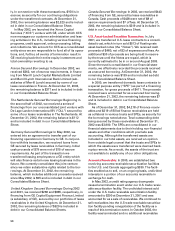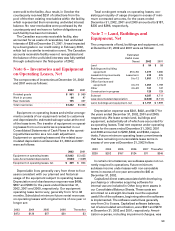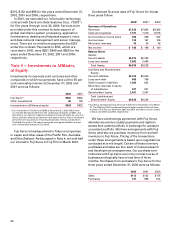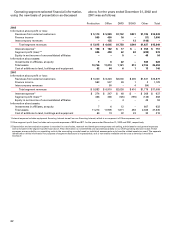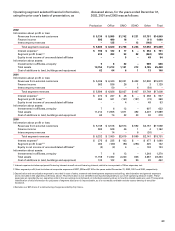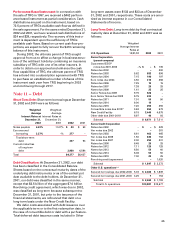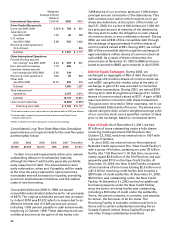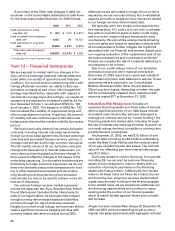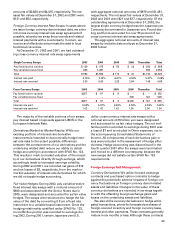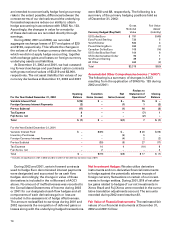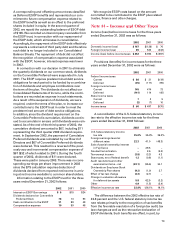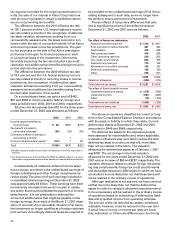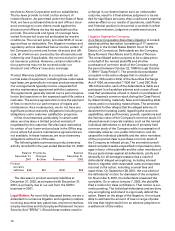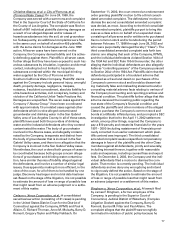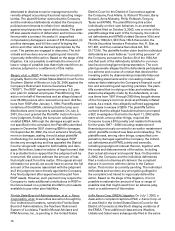Xerox 2002 Annual Report Download - page 70
Download and view the complete annual report
Please find page 70 of the 2002 Xerox annual report below. You can navigate through the pages in the report by either clicking on the pages listed below, or by using the keyword search tool below to find specific information within the annual report.
68
A summary of the Other cash changes in debt, net
as shown on the consolidated statements of cash flows
for the three years ended December 31, 2002 follows:
2002 2001 2000
Cash payments on notes
payable, net $ (33) $ (141) $ (1,277)
Cash proceeds from long-term
debt, net(1) 1,053 89 10,131
Cash payments on long-term
debt (5,639) (2,396) (5,816)
Total other cash changes in
debt, net $(4,619) $(2,448) $ 3,038
1 Includes payment of debt issuance costs.
Note 12 — Financial Instruments
We are exposed to market risk from changes in for-
eign currency exchange rates and interest rates that
could affect our results of operations and financial
condition. Our current below investment-grade credit
ratings effectively constrain our ability to fully use
derivative contracts as part of our risk management
strategy described below, especially with respect to
interest rate management. Accordingly, our results of
operations are exposed to increased volatility. As fur-
ther discussed in Note 1, we adopted SFAS No. 133,
as of January 1, 2001. The adoption of SFAS No. 133
has increased the volatility of reported earnings and
other comprehensive income. In general, the amount
of volatility will vary with the level of derivative and
hedging activities and the market volatility during any
period.
We have historically entered into certain derivative
contracts, including interest rate swap agreements,
foreign currency swap agreements, forward exchange
contracts and purchased foreign currency options, to
manage interest rate and foreign currency exposures.
The fair market values of all our derivative contracts
change with fluctuations in interest rates and/or cur-
rency rates and are designed so that any change in
their values is offset by changes in the values of the
underlying exposures. Our derivative instruments are
held solely to hedge economic exposures; we do not
enter into derivative instrument transactions for trad-
ing or other speculative purposes and we employ
long-standing policies prescribing that derivative
instruments are only to be used to achieve a very lim-
ited set of objectives.
Our primary foreign currency market exposures
include the Japanese Yen, Euro, Brazilian Real, British
Pound Sterling and Canadian Dollar. Historically, for
each of our legal entities, we have generally hedged
foreign currency denominated assets and liabilities,
primarily through the use of derivative contracts.
Despite our current credit ratings, we have been able to
restore significant economic hedging activities with
currency-related derivative contracts during 2002.
Although we are still unable to hedge all our currency
exposures, we are currently utilizing the re-established
capacity primarily to hedge currency exposures related
to our foreign-currency denominated debt.
We typically enter into simple unleveraged deriva-
tive transactions. Our policy is to use only counterpar-
ties with an investment-grade or better credit rating
and to monitor market risk and exposure for each
counterparty. We also utilize arrangements allowing
us to net gains and losses on separate contracts with
all counterparties to further mitigate the credit risk
associated with our financial instruments. Based upon
our ongoing evaluation of the replacement cost of our
derivative transactions and counterparty credit wor-
thiness, we consider the risk of a material default by a
counterparty to be remote.
Due to our credit ratings, many of our derivative
contracts and several other material contracts at
December 31, 2002 require us to post cash collateral
or maintain minimum cash balances in escrow. These
cash amounts are reported in our Consolidated
Balance Sheets as within Other current assets or
Other long-term assets, depending on when the cash
will be contractually released. Such restricted cash
amounts totaled $77 at December 31, 2002.
Interest Rate Risk Management: Virtually all
customer-financing assets earn fixed rates of interest,
while a significant portion of our debt bears interest
at variable rates. Historically, we have attempted to
manage our interest rate risk by “match-funding” the
financing assets and related debt, including through
the use of interest rate swap agreements. However, as
our credit ratings declined, our ability to continue this
practice became constrained.
At December 31, 2002, we had $7.0 billion of vari-
able rate debt, including the $3.5 billion outstanding
under the New Credit Facility and the notional value
of our pay-variable interest-rate swaps. The notional
value of our offsetting pay-fixed interest-rate swaps
was $1.2 billion.
Our loans related to vendor financing, from parties
including GE, are secured by customer-financing
assets and are designed to mature ratably with our
collection of principal payments on the financing
assets which secure them. Additionally, the interest
rates on all these loans are fixed. As a result, the ven-
dor financing loan programs we have implemented
create natural match-funding of the financing assets
to the related loans. As we implement additional ven-
dor financing opportunities and continue to repay
existing debt, the portion of our financing assets
which is match-funded against related secured debt
will increase.
Single Currency Interest Rate Swaps: At December 31,
2002 and 2001 we had outstanding single currency
interest rate swap agreements with aggregate notional


